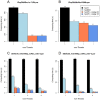fastsimcoal2: demographic inference under complex evolutionary scenarios
- PMID: 34164653
- PMCID: PMC8665742
- DOI: 10.1093/bioinformatics/btab468
fastsimcoal2: demographic inference under complex evolutionary scenarios
Abstract
Motivation: fastsimcoal2 extends fastsimcoal, a continuous time coalescent-based genetic simulation program, by enabling the estimation of demographic parameters under very complex scenarios from the site frequency spectrum under a maximum-likelihood framework.
Results: Other improvements include multi-threading, handling of population inbreeding, extended input file syntax facilitating the description of complex demographic scenarios, and more efficient simulations of sparsely structured populations and of large chromosomes.
Availability and implementation: fastsimcoal2 is freely available on http://cmpg.unibe.ch/software/fastsimcoal2/. It includes console versions for Linux, Windows and MacOS, additional scripts for the analysis and visualization of simulated and estimated scenarios, as well as a detailed documentation and ready-to-use examples.
© The Author(s) 2021. Published by Oxford University Press.
Figures

References
-
- Beaumont M.A. (2019) Approximate Bayesian computation. Annu. Rev. Stat. Appl., 6, 379–403.

